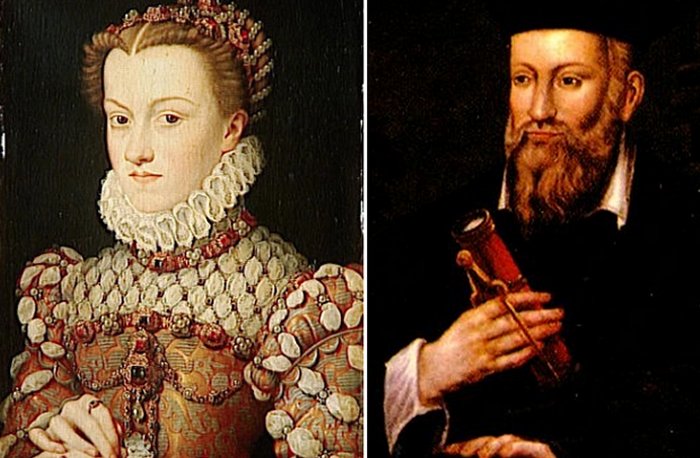Catherine De Medici – Queen Of France Supported Nostradamus, Was Suspected Of Poisoning And Blamed For Horrible Massacre
Ellen Lloyd - AncientPages.com - If you are a Queen or King, you’re expected to set a good example for the rest of the population, something many historical rulers seem to have forgotten about, or simply ignored. On the other hand, ancient Kings and Queens were also expected to deal with problems that gave rise to a serious threat to their nation’s political and religious stability.
This could be especially difficult to accomplish during the reign of Catherine de Medici when religious conflicts were on the rise in Europe.
Catherine de Medici (left) believed in prophecies and supported Nostradamus (right). Both images credit: Public Domain
Catherine de Medici, (1519 – 1589) has been called the most powerful woman in sixteenth-century Europe and some historians say she did not hesitate to exploit her authority as Queen of France. Did Catherine de Medici only do what was necessary when she responded to crisis brought on by the Protestant Reformation, or was she too dominant and added fuel to the escalating religious violence in France?
Was Catherine de Medici guilty of murdering an enemy with poisoned gloves? Why was she blamed for the horrible St. Bartholomew's Day massacre of 1572? Was she ruthless and evil or simply just desperate to keep the Valois monarchy on the throne at all costs? Were the witch accusations against Catherine de Medici pure fantasies or did she practice dark arts?
Catherine de Medici’s Early Years
As the descendant of one of the most powerful Italian families, the House of Medici, it’s no surprise that Catherine should one day become an influential person, but her early years were by no means a dance on roses.
Born on 13 April 1519 in Florence, Italy Catherine was the only child of the daughter of Duke Urbino, Lorenzo II of Medici, and Madeleine de la Tour. Catherine could never enjoy the company of her parents because they both died within a month of her birth. However, she soon became of interest to the Vatican. Two of Catherine's uncles were popes, Pope Leo and Pope Clement VII.
Pope Leo died when Catherine was only two-year-old, but when Pope Clement VII was elected in 1523, she ended up in the Palazzo Medici Riccardi in Florence. Catherine was important to Pope Clement VII because she could improve the Vatican's contacts with France.
Catherine de Medici Marries King Henry II Who Is In Love With Diane de Poitiers
When Catherine was 14-year-old she became the wife of King Henry II, who was the same age.
Catherine and Henry's marriage was not a love affair, and everyone was aware that the king had many mistresses. During her marriage with King Henry, Catherine had no political influence as queen. Henry’s great love and chief mistress, Diane de Poitiers received the Château of Chenonceau, in the Loire Valley and she was more powerful than Catherine.
Of course, the fact that Catherine did not give birth to any children for the first 10 years of their marriage did not exactly improve the situation. Catherine was under pressure to produce an heir. Finally, in 1544 she gave birth to a son who was given the name Francis.
 Catherine and Henry's marriage, painted seventeen years after the event. Credit: Public Domain
Catherine and Henry's marriage, painted seventeen years after the event. Credit: Public Domain
After conceiving once, it seemed no longer a problem to produce children. Catherine gave birth to 10 children and seven of them survived to adulthood, and three became kings.
However, her ability to give birth did not improve her marriage. King Henry was deeply in love with his beautiful, 20-year older mistress Diane de Poitiers.
Unexpected Death Of Catherine's Husband Henry II
Henry loved tournaments. On 30 June 1559, a tournament was held near Place des Vosges to celebrate the Peace of Cateau-Cambrésis with his longtime enemies, the Habsburgs of Austria, and to celebrate the marriage of his daughter Elisabeth of Valois to King Philip II of Spain.
Henry did not expect such a fatal end of his life. During a jousting match, Henry was fatally wounded in the eye by a fragment of the splintered lance of Gabriel Montgomery, captain of the King's Scottish Guard. During his life's last tournament, the king's lance wore the colors of Diane de Poitiers (1499 - 1566), his long-lived mistress rather than his wife's.
His life couldn't be saved. King Henry died ten years later, on 10 July 1559, at the age of 40.
Catherine de Medici As A King Mother
When King Henry passed away it was time for his 15-year-old son Francis II to ascend the throne. King Francis II married Maria, the Queen of Scots, but his reign did not last long because he died of an ear infection in 1560.
Eventually, the throne was taken over by his younger brother Charles IX who ruled as King of France for 14 years. However, King Charles IX was not very long-lived either and died at the age of 24. The next king became Henry III, who was Catherine’s favorite son.
Suspicions Of Murder With Poisoned Gloves
Catherine de Medici and her sons lived in difficult times, marked by the rising of religious tensions between Protestants (Huguenots) and French Catholics. In an attempt to solve their doctrinal differences, Catherine summoned church leaders from both sides, but she was unsuccessful and couldn’t reach an agreement that suited both parties.
The Huguenots, French Protestants who followed the teachings of John Calvin suffered severe persecution for their faith, but they were nevertheless gaining power and support from members of the nobility. The Huguenots retreated to the fortified stronghold of La Rochelle where they were joined by Jeanne d'Albret, the Protestant queen regnant of Navarre, and her son, Henry of Bourbon.
Henry of Bourbon and his mother Jeanne d'Albret. Credit: Both images public domain.
In a letter to the Queen of France, Jeanne d'Albret wrote: “We have come to the determination to die, all of us, rather than abandon our God, and our religion.”
Catherine de Medici declared Jeanne d'Albret, the most shameless woman in the world, but she tried to persuade her to come to the Royal Court, something Jeanne d'Albret refused to do.
However, finally, Jeanne d'Albret agreed and it was decided that her son and Margaret, a daughter of Catherine would marry, but only under the condition that Henry could remain a Huguenot.
When Jeanne arrived in Paris to buy clothes for the wedding, she was taken ill and died on 9 June 1572, aged forty-three. Huguenot writers later accused Catherine of murdering her with poisoned gloves. Still, Catherine de Medici’s guilt has never been proven.
Catherine de Medici Was Blamed For St. Bartholomew's Day Massacre
Catherine de Medici became hated and blamed for the horrible St. Bartholomew's Day Massacre in 1572. The massacre took place just some days after the wedding of Henry III of Navarre and Margaret. The bloody slaughter of the Huguenot happened on the night of 23–24 August.
One morning at the gates of the Louvre, 19th-century painting by Édouard Debat-Ponsan. Credit: Public Domain
Who was the initiator of this brutal massacre? Officially, it was King Charles IX who permitted it, but he did so under the pressure of his Catholic mother.
There are no exact numbers of how many people died, but it’s estimated that between 5,000 – 30,000 were killed in the massacre that lasted several weeks. The St. Bartholomew’s Day massacre also marked a turning point in the French Wars of Religion, the second deadliest religious war in European history that cost about 3 million people their lives.
Catherine de Medici's Support For Nostradamus And Interest In Art And Occult Knowledge
Catherine de Medici shared her family’s great love for art. She was also interested in astronomy, astrology, architecture and there were rumors she was fascinated with occult knowledge.
Since Catherine believed in prophecies, it’s no wonder that she became one of Nostradamus’ greatest supporters and admirers. Catherine de Medici made Nostradamus Counselor and Physician-in-Ordinary to King Henri's court. Nostradamus made many predictions that concerned Catherine de Medici and her family. Some of them turned out to be true and she valued his advice. It is even said that Nostradamus made a talisman for her.
 Catherine de Medici, by François Clouet. Credit: Public Domain
Catherine de Medici, by François Clouet. Credit: Public Domain
During her reign, Catherine de Medici was also accused of practicing dark arts that she taught her son Henry II. According to rumors, Catherine de Medici showed great interest in the occult. Her acquaintance with Cosimo Ruggeri, an Italian astrologer was one of the reasons why the Queen of France was suspected of dealing with dark, evil powers. Catherine gave patronage to the Ruggeri brothers and Cosimo was believed to be Catherine's own "trusted necromancer, and specialist in the dark arts". During his lifetime, Cosimo Ruggeri became well-known as a master of the occult, black magic, and witchcraft.
During the Renaissance the distinction between 'magician' and 'witch' was unclear and many queens and ordinary women were accused of witchcraft. There are very few historical documents that could shed light on the truthfulness of these rumors, though.
What we do know with certainty is that Catherine de Medici died on 5 January 1569, aged 69. She was always a strong-willed woman and without her, it’s unlikely that her sons would have remained in power.
Written by Ellen Lloyd – AncientPages.com
Copyright © AncientPages.com All rights reserved. This material may not be published, broadcast, rewritten or redistributed in whole or part without the express written permission of AncientPages.com
Expand for referencesMore From Ancient Pages
-
 Controversial Unexplained Ancient Mystery In Mongolia – Horrifying Sight – Part 2
Featured Stories | May 2, 2018
Controversial Unexplained Ancient Mystery In Mongolia – Horrifying Sight – Part 2
Featured Stories | May 2, 2018 -
 Yu Shi ‘The Master Of Rain’ Revered Deity In Chinese People’s Beliefs
Featured Stories | Mar 2, 2024
Yu Shi ‘The Master Of Rain’ Revered Deity In Chinese People’s Beliefs
Featured Stories | Mar 2, 2024 -
 Mysterious Advanced Underground Civilization And A Secret Society – Dangerous Knowledge And Verdict – Part 3
Featured Stories | Apr 24, 2018
Mysterious Advanced Underground Civilization And A Secret Society – Dangerous Knowledge And Verdict – Part 3
Featured Stories | Apr 24, 2018 -
 Unusual High-Tech Machine In The Bible Offers Evidence Of Lost Ancient Advanced Civilization
Biblical Mysteries | Aug 18, 2018
Unusual High-Tech Machine In The Bible Offers Evidence Of Lost Ancient Advanced Civilization
Biblical Mysteries | Aug 18, 2018 -
 Emperor Kublai Khan: One Of The Most Powerful People In Human History
Featured Stories | May 23, 2017
Emperor Kublai Khan: One Of The Most Powerful People In Human History
Featured Stories | May 23, 2017 -
 When Giants Ruled North America – Giant Skeletons ‘Erased’ From History – Part 2
Civilizations | Nov 22, 2018
When Giants Ruled North America – Giant Skeletons ‘Erased’ From History – Part 2
Civilizations | Nov 22, 2018 -
 Intriguing Connection Between Ancient Curse Tablets And The Book Of Revelation Discovered
Artifacts | Feb 9, 2023
Intriguing Connection Between Ancient Curse Tablets And The Book Of Revelation Discovered
Artifacts | Feb 9, 2023 -
 Mysterious Unknown Beings Who Walked The Earth With Humans
Featured Stories | Sep 15, 2020
Mysterious Unknown Beings Who Walked The Earth With Humans
Featured Stories | Sep 15, 2020 -
 Prehistoric Spread Of Millet From East Asia To Central Europe – New Study
Archaeology | Jun 10, 2022
Prehistoric Spread Of Millet From East Asia To Central Europe – New Study
Archaeology | Jun 10, 2022 -
 Why The Legend Of Robin Hood Is More Complex Than Previously Thought And Possibly Wrong
Featured Stories | Jul 30, 2022
Why The Legend Of Robin Hood Is More Complex Than Previously Thought And Possibly Wrong
Featured Stories | Jul 30, 2022 -
 Gobustan’s Petroglyphs And Yalli Dancers’ Amazing Musical Stone
Featured Stories | May 29, 2023
Gobustan’s Petroglyphs And Yalli Dancers’ Amazing Musical Stone
Featured Stories | May 29, 2023 -
 Unique Balchiria Stelae Engraved With A Goat-Like Figure Found On Corsica Is A Puzzle
Featured Stories | Feb 3, 2020
Unique Balchiria Stelae Engraved With A Goat-Like Figure Found On Corsica Is A Puzzle
Featured Stories | Feb 3, 2020 -
 Ancient City Of Aizanoi: Statue Heads Of Greek Gods Unearthed In Excavations
Archaeology | Nov 23, 2021
Ancient City Of Aizanoi: Statue Heads Of Greek Gods Unearthed In Excavations
Archaeology | Nov 23, 2021 -
 Ancient Textile Mystery: King Canute Enshrined In His Own Clothes But Found In His Brother’s
Artifacts | Oct 5, 2020
Ancient Textile Mystery: King Canute Enshrined In His Own Clothes But Found In His Brother’s
Artifacts | Oct 5, 2020 -
 Two Men Sentenced To Prison For Vandalism Of 4,000-Year-Old Petroglyphs In Nevada
Archaeology | Nov 12, 2022
Two Men Sentenced To Prison For Vandalism Of 4,000-Year-Old Petroglyphs In Nevada
Archaeology | Nov 12, 2022 -
 6,000-Year-Old Bizarre, Mouthless ‘Alien’ Mask Unearthed In “The Salt Pit” Settlement In Northeast Bulgaria
Archaeology | Nov 20, 2020
6,000-Year-Old Bizarre, Mouthless ‘Alien’ Mask Unearthed In “The Salt Pit” Settlement In Northeast Bulgaria
Archaeology | Nov 20, 2020 -
 New Evidence Reveals That Humans Settled In Americas At Least 13,000 Years Ago
Archaeology | Sep 4, 2017
New Evidence Reveals That Humans Settled In Americas At Least 13,000 Years Ago
Archaeology | Sep 4, 2017 -
 On This Day In History: Charter Of The Forest Was First Issued On London – On Nov 6, 1217
Featured Stories | Nov 6, 2016
On This Day In History: Charter Of The Forest Was First Issued On London – On Nov 6, 1217
Featured Stories | Nov 6, 2016 -
 Attila The Hun: The Destroyer Of Rome Among Most Fearsome Enemies The Empire Ever Faced
Featured Stories | Jun 24, 2019
Attila The Hun: The Destroyer Of Rome Among Most Fearsome Enemies The Empire Ever Faced
Featured Stories | Jun 24, 2019 -
 Rare 2,300-Year-Old Tomb Of Greek Courtesan Found In Jerusalem Burial Cave
Archaeology | Sep 28, 2023
Rare 2,300-Year-Old Tomb Of Greek Courtesan Found In Jerusalem Burial Cave
Archaeology | Sep 28, 2023



